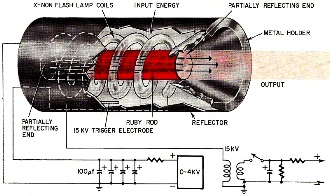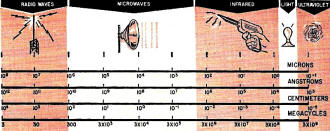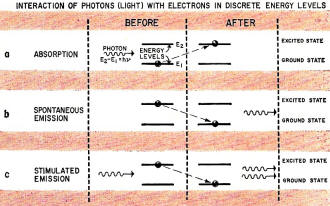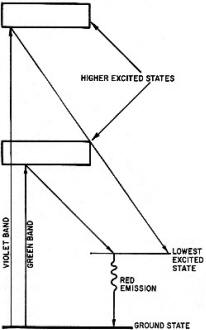Communications on 450,000,000 MC
|
|
When this "Communications on 450,000,000 MC" article appeared in a 1961 issue of Radio-Electronics magazine, MC (megacycles) was still being used rather than MHz (megahertz). Ditto for kC. Cycles per second (cps) were used in place of Hertz (Hz), and concepts like GC (GHz) and TC (THz) were rarely seen. Picofarads (pF) were designated as micromicrofarads (μμF). 450,000,000 MC is 450 terahertz, which is 6.66*10-7 m, or 666 nm (6660 Å). That is deep−red/near−infrared. Aside from using rubies, many early lasers were made from rear earth materials like YAG and neodymium, or from gases like CO2 and He-Ne. Semiconductor lasers were decades off. The first ruby laser was demonstrated just a year earlier by Theodore Maiman at Hughes Research Laboratories. Lasers were moving out of the science fiction realm and into laboratories. Now, they're ubiquituous. Communications on 450,000,000 MCThe optical maser is a source of coherent, monochromatic light. By modulating and amplifying this coherent light emission, it will be possible to use light as radio waves are used today. Until now, there were coherent sources of electromagnetic waves only for frequencies less than 105 mc (1011 cycles) (Fig. 2). The optical maser has raised this limit almost 10,000 times. And not only has the frequency been increased but the sharpness - or fractional bandwidth - has also been improved.
Maser stands for microwave amplification by stimulated emission of radiation. Following the proposal by Prof. C. H. Townes of Columbia University and Dr. A. L. Schalow of Bell Telephone Laboratories to extend the maser principle from the microwave region to the optical spectral region, some people have used the acronym laser, the letter l standing for light. But since the principles are the same in both cases, the tendency simply to say "optical maser" is growing. The ruby optical maser as reported by Bell Telephone Laboratories and similar to the Hughes Research Group's development consists of a Linde synthetic pink ruby rod 0.20 inch in diameter and 2 inches long. Both ends of the rod are optically polished to make them flat within 2 x 10-6 inches and parallel to within 10 seconds of arc. The end surfaces are made partially reflective, allowing only about 5% of the light striking them to pass through. A source of input power, a xenon-filled flash lamp, surrounds the ruby rod. It is pulsed by discharging a bank of capacitors through it. Charged to 4,000 volts, the bank delivers 3,000 joules to the lamp in about 1 millisecond. Fig. 1 shows both the mechanical and electrical details of the construction of a pulsed-ruby optical maser. In the bottom section is a 0-4,000-volt power supply, used to charge the bank of four 100-μf 4,000-volt capacitors. The series resistor limits the charging current. Also shown is the supply for the 15-kv transient that triggers the FT524 flash tube. A funnel-shaped cone holds the ruby rod axially within the helical coil of the flash tube. Surrounding the entire assembly of holder and lamp is a reflector. It can be either highly polished aluminum sheet or powdered magnesium oxide. It contains the flash-lamp output so a large fraction of it will be absorbed by the ruby. The output of the flash lamp is white light but only the green and violet portions of it can be absorbed by the ruby. Besides the essential parts-ruby, flash lamp and reflector - a coolant for the ruby and flash tube, and opaque shields surrounding the exterior parts complete the maser. Atoms and Radiation Why a maser - optical or microwave - operates can be understood with the help of Fig, 3. This drawing shows the interaction of an atomic system and radiation. Fundamentally, the only difference between microwave masers and the new optical ones is the spacing between the energy levels. In the microwave maser, these levels are separated only 1/10,000 as far as in the optical maser. All atomic and molecular systems have their electrons in such discrete and separate energy levels. "Discrete and separate" means that only certain amounts of energy can be stored by the electron in atoms or molecules. An electron can increase its energy by absorbing, from an electromagnetic wave striking it, an amount of energy just equal to the difference between two levels. Conversely, it can decrease its energy by emitting a photon - a pulse of electromagnetic radiation equal in energy to the spacing between two levels. The frequency of the radiation emitted in such processes is proportional to the energy. Normally, in an atomic system, the electron is in the lowest energy level or ground state. If an electromagnetic wave (photon) strikes the system (Fig. 3-a), the electron absorbs the photon energy. But if the system has been prepared (by applying energy from some outside source) with more electrons in excited states than in the ground state, a wave would not cause absorption, but rather would cause the emission of radiation. This process is called stimulated emission (Fig, 3-c) to distinguish it from spontaneous emission. Fig. 2 - Frequency spectrum shows relationship of electromagnetic waves. Fig. 3 - Interaction of an atomic system and radiation: a - Absorption; b - spontaneous emission; c - stimulated emission. Spontaneous emission is the kind that occurs when the excited electron emits energy and decays to the ground state without the help of an incident wave (Fig. 3-b). Spontaneous emission is important in a maser since it is the dominant loss mechanism. That is, the input power must be greater than the stimulated emission before maser action can occur. For maser operation, a system is prepared so that more electrons are in an excited state than in the lower state, A light wave passing through the atom then stimulates emission and thus is amplified. (When a system has more electrons in an upper excitation state than in a lower state, it is said to have an inverted population. Ruby, which is crystalline aluminum oxide (Al2O3), with chromium atoms substituted for some of the aluminum atoms, has a set of energy levels well suited for use as an optical maser. This particular set of levels is for an electron attached to the chromium ion (Cr+++). It is the absorption of green and violet light by these ions that gives ruby its familiar red color. Fig. 4 shows the steps whereby the absorption of green and violet light can be used to create an inverted population. Electrons, excited by the absorption of green or violet light, are driven from the ground state to the higher excited states shown in the figure as solid rectangles. From these highly excited levels the electrons fall rapidly to the lowest excited energy state giving some energy to the crystal lattice in the process. This lowest excited state has a long lifetime for spontaneous decay (about 3 milliseconds) and is therefore called metastable (comparatively stable). From the metastable level, the electron drops to the ground state, radiating energy as red (6943Å) light. A large number of the Cr+++ ions in ruby can have ions in the metastable level when a strong green light shines on the crystal. If electrons arrive in the metastable state faster than they return to the ground state, the electron population will become inverted. The xenon flash lamp is an intense enough source of green and violet light that more than half of the Cr+++ ions have their electrons in the metastable level for short periods of time. When the Cr+++ ions are in an "inverted-population" state, red light passing through the ruby will stimulate emission and thus be amplified. To make an oscillator, the flat ends of the ruby rod can be made partially reflecting, allowing some light to be fed back and further amplified. Let us now examine in detail the operation of the oscillator. After the inversion is accomplished through the excitation provided by the green light, the excited electrons begin to return to the ground state by emitting red light. Most of this light, being emitted as spontaneous emission, will be lost, since it is emitted in all directions, and any light striking the sides will leave the crystal. A small part will be emitted along the axis of the ruby cylinder. This small part, while traveling down the crystal, will stimulate more radiation by interaction with the excited electrons in the Cr+++ ions. The stimulated emission is directed along the axis of the cylinder. With growing intensity, the light wave moves down the ruby crystal and finally strikes the reflecting end. These ends allow approximately 5% of the light to escape from the crystal. The other 95% is reflected to make another pass through the crystal. On this, as well as along succeeding passes, it will stimulate emission and be amplified. In this sense, the process is analogous to a regenerative radio-frequency circuit, where part of the energy is fed back to produce still more energy. The red-light output of a ruby maser is an electromagnetic wave at 4.3 x 108 mc. As a result of passing the light back and forth between the end plates in the oscillator, standing waves of the light are set up the crystal. The emission stimulated by this standing wave will then have the same phase across any section of the rod, including the partially reflecting end plates. It will be coherent across the end faces. Since the radiation transmitted through the ends (the 5% not reflected) consists of a single phase, directional beams are possible. Normal radio or radar antennas may be several hundred wavelengths wide and have beam widths of several degrees. The optical maser is about 10,000 wavelengths across and has a beam width of 0.01°. This property of coherence, therefore, makes possible a very directional beam. The extremely narrow cone of emission is remarkable particularly when compared to a normal light source. The radiation from all other light sources is emitted uniformly in all directions (even in the maser rod itself the spontaneous portion of the emission is so radiated) while only the maser emission is confined to the narrow cone. Some idea of the cone width can be obtained from the experimental results obtained by the Bell Telephone Laboratories group. They observed that light from the maser covered a circle about 200 feet in diameter at a distance of 23 miles. Fig. 4 - Steps whereby absorption of green and violet light can be used to create an inverted population. The frequency bandwidth of an optical maser is much narrower than the bandwidth of the spontaneous radiation from the same material. At room temperature (3000 Kelvin) the spontaneous decay of electrons from the metastable level (Fig. 4) in ruby to the ground gives an emission with a width between the half-power points of 3A. or 1.8 X 105 mc. When maser action begins and the decay is dominated by stimulated emission, the width decreases by a factor of 100. This decrease in line width results from the feedback employed in the maser. The analogous situation in electronic circuitry - where positive feedback may be used to sharpen selectivity in a communications receiver, or unwanted regeneration may ruin the response of a television or FM if stage - is well known. The pulsed ruby maser is the most powerful monochromatic light source now available. In a bandwidth of 6 x 102 mc, ruby optical masers generate about 1 kw. By comparison, the standard high-purity light sources available in the past, such as the mercury arc, would emit only fractions of a watt in a comparable bandwidth. Furthermore, in such sources the energy was emitted nearly uniformly in all directions - the optical maser light is confined to a narrow cone. A good way of thinking about the brightness of a radiation source is in terms of its temperature. The sun has an apparent temperature of about 6,000°K, and within a bandwidth comparable to that of the ruby maser emits about 1/20 watt per square centimeter. Masers emit kilowatts/cm2. Moreover, the sun radiates its energy in all directions, while the maser does not. For the sun to radiate as much optical power within the same frequency limits and solid angle as the ruby maser, its temperature would have to be 1010° K. An unexpected discovery during the development of the ruby maser was that the output was not continuous. The output consists of a series of short bursts of emission during each pulse. Relaxation oscillations were obviously taking place. Two Other Masers Soon after the development of the first optical maser, two more pulsed masers were announced by the International Business Machines Corp. (IBM). Both the new masers used calcium fluoride as a host lattice. When the rare-earth element samarium was added to the CaF2 crystal in small amounts, maser action was observed at 7,020 Å, or 4.21 X 108 mc. It is also possible to include small amounts of uranium in crystals of CaF2 during growth. The uranium causes a spontaneous fluorescence in the infrared (1.21 X 108 mc) which has allowed a maser to be operated at 2.49 microns. Both of the masers using CaF2 have been cooled below 20°K when operated. Although these masers - like the ruby - are operated in a pulsed manner, in the future continuous operation should be possible. This possibility results from the much lower power needed to produce an inverted population. The fluorescent transition does not involve return to the ground state as in ruby. It is a transition between two excited states. Therefore, to obtain an inverted population it is not necessary to excite half the total atoms as in ruby, but only a small fraction of them. At present, the solid-material optical masers have all been pulsed. The Bell Telephone Laboratory has recently observed optical maser action in dark red ruby, which has a higher chromium content than the pink type. The increased Cr+++ content introduces new energy levels, which are used in the new maser. Optical maser action in the dark red ruby is at 4.28 and 4.26 X 108 mc. A Gas Maser The first optical maser to operate continuously was announced recently by Bell Telephone Laboratories. It is a mixture of gaseous helium and neon. This system differs in appearance and mechanical details, but in the principles of inverted population and optical feedback is the same as described for ruby. The gas maser is a meter-long glass tube, filled with a mixture of helium and neon in the ratio of 10 to 1. It looks superficially like an ordinary neon tube. The ends of the tube are partially transmitting plane parallel mirrors. These windows are aligned parallel to each other by an external optical system. External power to excite the atoms is supplied by a 28-mc generator delivering 50 watts. Most of this rf energy is coupled to the helium. Through collisions, energy is transferred from the helium to the neon atoms. This produces an inversion of the population between excited states in the neon atoms. The energy levels between which inversion occurs are not single pairs as in ruby and calcium fluoride. In fact, 32 such pairs are known to exist. Up to the present, maser action has been observed between only five of these pairs, producing frequencies of 2.68 X 108, 2.6 X 108, 2.58 X 108, 2.50 X 108 and 2.48 X 108 megacycles in the near infrared. The emission from the gas maser has, of course, all the properties of directionality, coherence and sharply defined frequency. Indeed, the frequency band emitted is only about 10 kc wide, which gives a fractional bandwidth of about 10-10. Due to the low density of atoms in a gas, the output power is less for gas than for solid-state masers. Applications With the development of these powerful, coherent and monochromatic light sources, many new uses of light will become possible. In the past, no light combined all three of these properties to the same extent and at the same time. One immediate application would be optical radar. Since the wavelength is so much shorter than that of present radars, the resolution could be much higher. Radar systems operating at 1 cm with antennas several meters in height have a beam width, and hence definition, of about 0.5°. This might be compared with an optical maser 1/2 cm in width, with a beam width of 0.05°, which through the addition of a simple optical lens system an inch or so in diameter could easily be reduced to 0.005°. With such a narrow beam width, radar systems could easily identify the actual shapes of aircraft. Because of the vast new frequency space that will be opened in the future, the communications industry is vitally concerned with maser developments. At present, communications links operate up to about 104 megacycles. The optical maser will extend that range to 1014 cycles. This advance is particularly striking when one remembers that all of the frequency span now available to us is contained in 10% of the new region. To appreciate the significance of this, it is only necessary to realize that a color TV channel requires a bandwidth of nearly 10 megacycles. If the existing channels were used in a 10% modulation system, about 100 channels would be available. This is certainly adequate for TV but there is no space left for data transmission or telephony. On the other hand, an optical maser at 108 mc with a 10% bandwidth could handle 106 TV channels and still have a bandwidth of 107 mc left for other uses. The directional property of optical masers will be useful in earth-to-satellite, satellite-to-satellite and earth-to-moon links. For example, if the output of an optical maser were sent through a simple lens system 4 inches in diameter, the radiation would cover only 2 miles at the surface of the moon. This indicates the possibilities of private communications. In addition to these applications, the optical maser might be used as a tool to effect chemical reactions. Maser emission is coherent; it can therefore be focused into an area of dimensions comparable to wavelengths of light. Under these conditions all the maser energy could be concentrated within single living cells and selective destruction of tissue (surgery) be performed. The optical maser can extend greatly the range over which interferometric measurements can be made. Present optical interference measurements are limited to about 100 cm due to inherent line width and low power of monochromatic sources, but significant increases in length are now possible. We have mentioned a few new applications and scientific uses of light made possible by the optical maser. Most of the new uses will probably be in directions that are not yet apparent. However, we have indicated regions where it is thought uses will be found in the near future.
Posted August 15, 2023 |
|

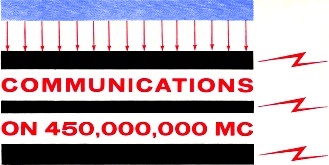 By R. J. Collins and D. F. Nelson
By R. J. Collins and D. F. Nelson 